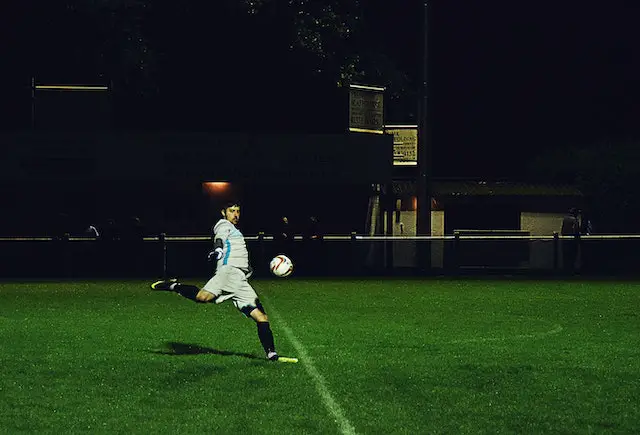In the world of soccer, there is a term that has been buzzing around for quite some time. The “false nine.” But what exactly does it mean?
Well, imagine a player who is not your typical forward, but instead plays deeper in the midfield, lurking between the lines of the opposition’s defense. This player has the ability to drop back and create spaces for others to exploit, confusing the defenders with their unpredictable movements.
Additionally, the “false nine” is a tactical approach that challenges traditional striker roles and has been utilized by top teams to great effect.
So, let’s unravel the mysteries of the “false nine” and discover how this strategic twist is changing the game.
1. Definition of a False Nine
A false nine is a tactical position in soccer where a forward, traditionally the number nine, operates deeper in the attacking line, dropping into midfield. The purpose of playing a false nine is to confuse and disrupt the opposition’s defensive structure. This action creates spaces for teammates to exploit.
Truly, this position requires technical ability, intelligence, and a good understanding of the game. This article on the soccer formations explains explicitly the best formations in which a “false nine” can better strive.
2. Origins of the False Nine Position
The concept of a false nine can be traced back to the 1960s when Hungarian coach Bela Guttmann first experimented with the idea. He deployed Ferenc Puskás in a deeper role during the 1962 World Cup, allowing him to influence the game more by dropping off the defensive line. This unorthodox approach proved effective and became the foundation for the false nine position.
3. Characteristics of a False Nine
A false nine possesses a unique set of characteristics that differentiate them from traditional center-forwards. They have excellent technical skills, as they often need to receive, control, and distribute the ball in tight spaces. T
heir ability to read the game is crucial, as they must constantly assess when to drop deep, when to stay higher up the pitch, and when to make runs into the box. Additionally, masquerading as a midfielder, they should also possess good passing ability and be capable of creating goal-scoring opportunities for teammates.
4. Tactical Role of the False Nine
The tactical role of a false nine is multifaceted. By operating in a deeper position, they create a dilemma for the opposition’s defenders.

If the center-back ventures out to mark the false nine, it opens up space behind for wingers or attacking midfielders to exploit. On the other hand, if the defenders stick to their positions, the false nine is given time and space on the ball to orchestrate attacks, either by threading through passes or taking on opponents themselves.
The false nine’s positioning also pulls defenders out of position, creating gaps and opportunities for other forwards to exploit. By dropping into midfield, they effectively create an overload in the center of the pitch, allowing their team to dominate possession and control the tempo of the game.
5. Famous Players Who Have Played as False Nines
Several notable players have excelled in the false nine role throughout the history of soccer. One of the most renowned is Lionel Messi, who has frequently operated as a false nine for Barcelona, wreaking havoc on opposing defenses. Messi’s ability to drop into midfield, drive at defenders, and create goal-scoring opportunities for himself and his teammates has revolutionized the position.
Manchester City under the leadership of Pep Guardiola strived playing the false nine strategy. Infact the won the 2021/2022 Premier League(best league in the world) utilising the false nine almost all season even though they had traditional nines like Aguero and Gabriel Jesus. Pep used Kevin De Bryne and sometines Phil Foden on multiple occasions on the false nine role.
Also, Cesc Fàbregas, during his time at Arsenal and Barcelona, also showcased his ability to play as a false nine. His intelligent movement, passing range, and goal-scoring instincts made him a challenging player for defenders to handle.
Francesco Totti, Francesco Baiano, and Roberto Baggio are also among the notable players who have successfully adopted the false nine role.
6. Advantages of Playing with a False Nine
Playing with a false nine offers several advantages to a team’s style of play.
Firstly, it provides an element of surprise. As the opposition’s defenders are accustomed to dealing with a traditional center-forward, the false nine’s deep-lying position can catch them off guard and disrupt their defensive strategies. This confusion opens up spaces for other attackers to exploit.

The false nine’s ability to drop into midfield provides an extra passing option and allows the team to maintain possession in tighter areas.
Their technical skills and vision make them effective at creating scoring opportunities for teammates or taking shots themselves. This versatility adds unpredictability and creativity to the team’s attacking play.
7. Disadvantages of Playing with a False Nine
While the false nine position offers numerous benefits, it also presents certain disadvantages. One major drawback is the potential lack of a traditional target man in the box. As the false nine often drops deep, it can leave the team without a focal point in the penalty area. This absence of a target man can make it challenging to convert crosses or play direct long balls.
Additionally, the false nine’s deep-lying position can sometimes leave the team susceptible to counter-attacks. If the opposition gains possession in advanced areas and quickly breaks forward, there may be a gap in the team’s defensive structure, as the false nine may not be in a position to track back and provide defensive cover.
8. Variations of the False Nine Position
While the traditional false nine operates as a withdrawn center-forward, there are variations of the role based on the team’s playing style and the specific attributes of the player in that position.
Some teams may opt for a “roaming” false nine, who constantly moves across the attacking line, creating confusion and gaps in the defense. Others may choose a “false ten,” where the player occupies a hybrid role combining the traits of a central midfielder and a forward.
The false nine position can also be interchanged with other attacking positions, with players taking turns dropping deeper or making runs into the box. These variations offer coaches flexibility in adapting their tactics and exploiting the opposition’s weaknesses.
9. Criticisms and Controversies Surrounding the False Nine

Despite its success, the false nine position has not been immune to criticisms and controversies. Some argue that this role can disrupt the team’s balance by sacrificing a traditional striker, leading to a decrease in the number of goals scored. Others contend that the position relies heavily on the individual brilliance of the player in that role, and if the false nine is neutralized, the team’s attacking threat diminishes significantly.
There have also been debates regarding the physical demands of playing as a false nine. As the position requires the player to constantly drop deep, press opponents, and create scoring opportunities, it can be physically taxing and may require the player to possess a high level of stamina.
10. Conclusion
The false nine position has become a prominent tactical option in modern soccer, thanks to its ability to disrupt defenses and create opportunities for teammates. With players like Lionel Messi exemplifying the effectiveness of this role, it has become an integral part of many teams’ strategies.
While the false nine offers numerous advantages, such as surprise factor and increased creativity, it also presents challenges, such as the lack of a target man in the box and potential defensive vulnerabilities. Ultimately, the decision to adopt the false nine position relies on the team’s style of play, the players’ attributes, and the opposition’s defensive structure.
As soccer continues to evolve, it is likely that the false nine position will continue to be developed, experimented with, and refined. Its impact on the game is a testament to the constant innovation and creativity that drives the sport forward.


